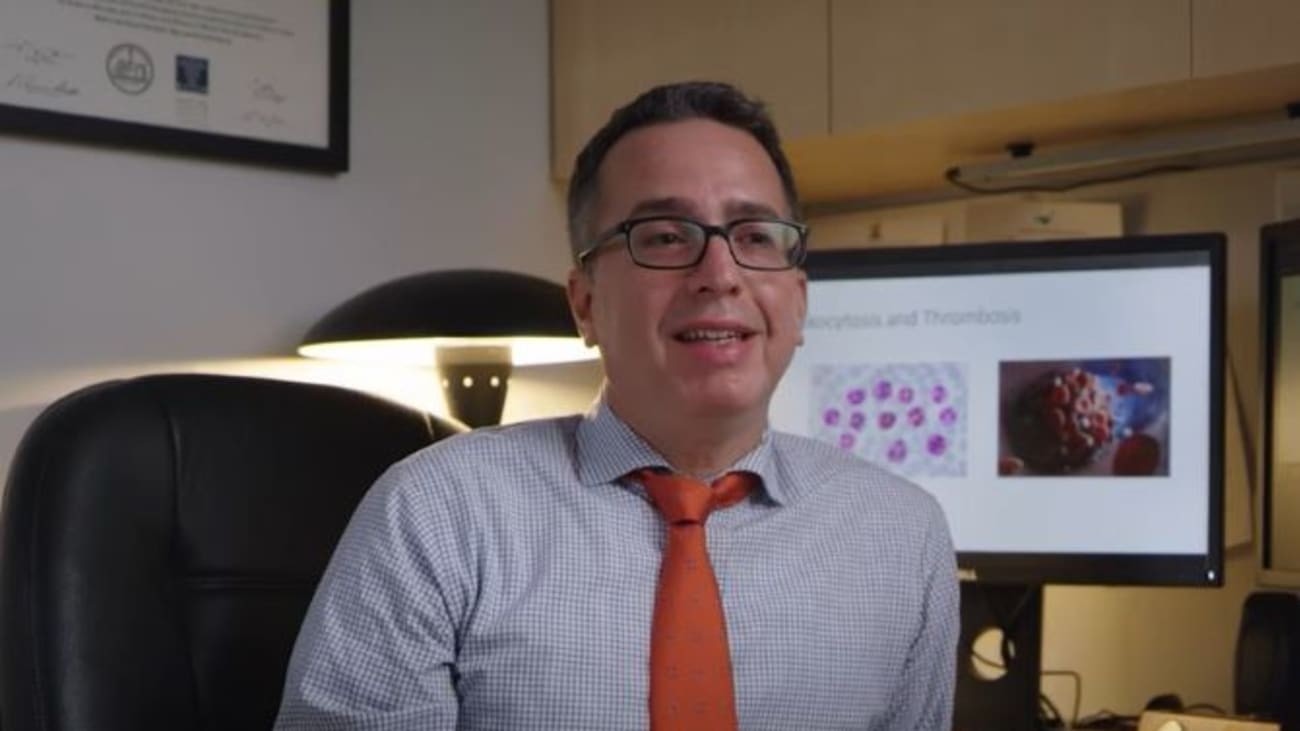The ECLIPSE study was designed to assess whether a more aggressive titration schema for ropeginterferon would lead to an earlier attainment of complete hematologic response in patients with polycythemia vera.
my name is john Mascarenas. I'm here at the Icahn School of Medicine at Mount Sinai in new york city. Today, I'm gonna be talking about the eclipse study. This is a proposed uh randomized phase three B. Study of rope peg interfere on otherwise now known as the commercial name of best Remy in patients with policy Tamia vera. And this study really has been in development and is um is a dynamic study. The original concept of the study was to assess whether a more aggressive tight rations schema for rope peg interferon would lead to an earlier attainment of a complete pathologic response compared to the way different was evaluated in the proud PV study which was the pivotal study that ultimately contributed to the approval of this drug both in the EU and in the U. S. For patients with policy. And of course Ro RO PEG interferon isn't interferon ALFA two B. Um It's a mono regulated form of the drug. So it has a more um attractive farm co kinetic profile um than uh than other populated formulations of interferon. Um and was approved for policy Tenia vera based on the proud PB and continuation PV results which demonstrate um hi completely mythological emission rates um but probably more importantly and more um excitingly is uh complete molecular remissions in a subset of patients. Um and it's been reported um that 25% of patients that are treated with interferon can achieve these kinds of deep responses. And if you look at the the response curve for molecular responses compared to hydroxyurea which was the comparator arm in the county p. V. and and um and probably the study um That after about two years of therapy uh rope again if Iran was clearly superior in inducing molecular responses and of course that is what is believed to be unique um And important in the potential to deliver disease course modification for patients with policy to me vera with this agent. However um there were some uh some in the community however there were some of the community that question whether the slow tight rations of rope interference starting either at 50 micrograms or 100 micrograms depending on whether someone is already on hydroxyurea. And then tight trading up every two weeks. It's just every two weeks to a maximum tolerated dose of 500 micrograms every two weeks was necessary. And if one could instead titrate faster. Um in a 2 53 5500 schema. Um So within six weeks to get to the target dose um as the drug is well tolerated. Um And it's not clear that one needs a slow tight rationing and therefore one could get a quicker completely mythological response rate. Um With rope peg interferon as one sees with hydroxyurea. So that really was the fundamental basis of developing the eclipse study which was originally a phase three B. Study single arm um evaluating the ch ch. R. Rate at week 24 with rope peg interferon at 2 53 5500 microgram escalation every two weeks. Um More recently we've had discussions internally um and we are now exploring the potential to to transform this study into a randomized study. Um comparing the more aggressive 2 53 5500 schedule to the slower schedule that is currently indicated in the package insert for the drug. Um Starting either 50 micrograms or 100 micrograms and tight trading up to 500 micro micrograms Um every two weeks um in 50 microgram intervals. Um whether we will hit a faster chr a. Um and potentially avoid additional toxicity will be assessed in this trial. Um And I think will will um will likely be um um package insert um changing if it does in fact lead to a faster CHR rate. Um But also key secondary endpoints will be important to evaluate um such as um tolerable itty um durability of response and then whether there is a beneficial impact on molecular response at this faster hydration um schema. So this is an important study as it will refine and and and ideally inform optimal optimization of dosing schedules for rope peg interferon which remains a therapeutic option for policy to me vera. Um And really the only drug that has durable data for molecular responses which we believe should translate to disease course modification. And of course it's it's also good to point out that rope urine is also currently in Phase three testing for essential thrombosis ischemia. In the surpassed study. This is an ongoing global Phase three study um, comparing Ropeik interferon to uh relied in patients with uh essential thermos ischemia that have had prior exposure to hydroxyurea and either relapsed refractory or intolerant. So the potential for this drug across multiple disease states, including early milo fibrosis and pre fiber optic form of milo fibrosis, as presented at ash, um offers the potential to increase our armamentarium with therapies that have anti colonial, anti stem cell directed activity. So we look forward to further um clinical evaluation of rho peg interferon alpha two B in patients with diverse Millat plazas.



